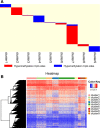Specific breast cancer prognosis-subtype distinctions based on DNA methylation patterns
- PMID: 29675884
- PMCID: PMC6026876
- DOI: 10.1002/1878-0261.12309
Specific breast cancer prognosis-subtype distinctions based on DNA methylation patterns
Abstract
Tumour heterogeneity is an obstacle to effective breast cancer diagnosis and therapy. DNA methylation is an important regulator of gene expression, thus characterizing tumour heterogeneity by epigenetic features can be clinically informative. In this study, we explored specific prognosis-subtypes based on DNA methylation status using 669 breast cancers from the TCGA database. Nine subgroups were distinguished by consensus clustering using 3869 CpGs that significantly influenced survival. The specific DNA methylation patterns were reflected by different races, ages, tumour stages, receptor status, histological types, metastasis status and prognosis. Compared with the PAM50 subtypes, which use gene expression clustering, DNA methylation subtypes were more elaborate and classified the Basal-like subtype into two different prognosis-subgroups. Additionally, 1252 CpGs (corresponding to 888 genes) were identified as specific hyper/hypomethylation sites for each specific subgroup. Finally, a prognosis model based on Bayesian network classification was constructed and used to classify the test set into DNA methylation subgroups, which corresponded to the classification results of the train set. These specific classifications by DNA methylation can explain the heterogeneity of previous molecular subgroups in breast cancer and will help in the development of personalized treatments for the new specific subtypes.
Keywords: DNA methylation; breast cancer; consensus clustering; molecular subtypes.
© 2018 The Authors. Published by FEBS Press and John Wiley & Sons Ltd.
Figures





References
-
- Arnedos M, Vicier C, Loi S, Lefebvre C, Michiels S, Bonnefoi H and Andre F (2015) Precision medicine for metastatic breast cancer – limitations and solutions. Nat Rev Clin Oncol 12, 693–704. - PubMed
Publication types
MeSH terms
LinkOut - more resources
Full Text Sources
Other Literature Sources
Medical

